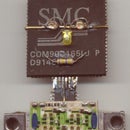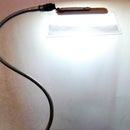Introduction: Switch Mode LED Torch
I modify a cheap chinese rechargeable torch with a switch mode LED drive circuit.
The advantage over the original circuit is that it has constant brightness even when the battery voltage drops as it discharges, down up to the very end when its voltage goes below 2.7 volts.
The torch had seven LEDs in an aluminized plastic reflector, and a three position switch lighting zero, three or seven LEDs on successive positions. The LEDs were all connected to the 4 volt sealed lead acid rechargeable battery with independent resistors.
When the battery died, I replaced it with a 3.6 volt nicad pack from a defunct mobile phone I had lying around, and it worked, but the brightness had dropped. Replacing all resistors to raise the current through the LEDs (all seven of them) was thought to be too much of a chore, so I went ahead and wired them all in series. Now I had seven LEDs in series, requiring about twentyfour volts to light them, at around twenty milliamps.
Then I used an integrated circuit driver to raise my battery voltage to the value required.
Step 1: The Schematic
This is the circuit I intend to use: The texas instruments TPS61041 LED driver, wired up according to the circuit in the datasheet, reproduced below.
TI make the circuit, so they are the people to tell me how to use their chip. It looks simple: Two capacitors to store energy and decouple the supply voltage and output voltage, a rectifier, an inductor, and finally a resistor to set the LED current.
According to the datasheet, as long as the other components are correctly chosen and wired up right, the LED current depends only upon the value of the resistor Rs in the figure below. It doesn't matter how many LEDs there are, and what voltage the battery has.
This particular integrated circuit can drive LEDs in series up to 28 volts, and the input voltage has to be in the range 2.7 volts to 6 volts. Since a white LED requires around 3.5 volts, upto eight of them in series may be used. Since the minimum voltage has to be 2.7 volts, at least two NiCd cells in series would be required to drive it - or one Li-ion.
Step 2: My Circuit, Compared With the Original Torch
The drawing below shows the original circuit above, and my modifications below.
The original battery charging portion of the torch is retained without changes.
The seven white LEDs are connected in series.
A circuit with the TI TPS61041 integrated circuit is interposed between LED string and battery.
Step 3: Board Layout With Pen and Pencil
First, of course, I have to lay out the circuit on a piece of copper clad board. The TPS61041 is a tiny chip with five leads and to match its size the other components are all SMD, too. The easiest way to use SMD components is with a printed circuit board.
My proposed layout is shown, copper outlines in pencil and components drawn with ink.
Step 4: The Chip and the Board
This shows the pattern scribed on a piece of copper clad board, and the integrated circuit. It is too much work etching the board, so the desired pattern was cut on the board with a sharp knife.
Step 5: The Unpopulated Board
This is the board, a better view. The space around the chip was traced on the board, and the markings used to guide the path of a sharp point of a hobby knife. Two cuts, along the same line, with the knife slanted first one way and then the other will leave a small insulating channel between the adjacent copper lands.
Step 6: The All-important Resistor
This resistor, shown soldered on to the board, sets the current through the LED string. On it is written "680" which has to be interpreted as a six, an eight, and zero number of zeroes following, in ohms. Its value is sixty eight ohms and results in an LED current of about eighteen milliamps.
Step 7: Supply Decoupling - Input Capacitor
An electrolytic capacitor, ten microfarads, is placed across the input voltage. This particular unit is a surface mounting tantalum capacitor, probably from a broken hard drive.
Step 8: Output Capacitor and Rectifier Diode
All components other than the chip and the inductor have been placed in position.
Step 9: The Completed Circuit
The circuit is now complete, and ready for the smoke test.
All solid state electronics work because of the magic smoke infused into it by the manufacturers. If we carelessly let the magic smoke out, then the electronics aint gonna woik any moar.
This assembly is now ready for the magic smoke test.
Step 10: The Smoke Is ... IN!
Here, I have connected it to the seven LED string and am applying power from a battery pack.
That black box contains four AAA cells, or six volts. The series resistor should limit the damage should something be amiss.
The LEDs light, and voltage checks around the circuit do not show anything out of the ordinary. It is time to box it up.
Step 11: The Finished Circuit
This is how it was finally tested - with two AA cells in a holder, wired directly to the board.
The board is small enough to be stuck behind the LEDs, and the assembly can be placed into the original torch body.
Does this torch work better now, that some highly sophisticated electronics is inside it?
Hardly. A torch is not something which can be "improved". For simplicity, the original circuit was hard to beat, and running time after a charge can be improved by simply using a larger battery.
However, if someone is looking to add lights to a gadget where space and power (and maybe weight) is at a premium, this sort of LED drive circuit might come in useful.
Step 12: Fine Tuning
After the torch was put together, I measured the LED current and found that it was somewhat less than the 18 mA dictated by the resistor value of 68 ohms. I added an additional capacitor (4.7 microfarad, 35 Volts, tantalum bead) across the output of the chip. There was no change in current, but I left it in position anyway.
Next, I tried various other inductors in place of that hand wound toroid inductor. A moulded inductor marked 39 microhenries resulted in the full 18 mA of current and these two modifications can be seen in the photo below.
The circuit in the datasheet specifies a schottky diode. I have used an ordinary silicon surface mounting diode which might be a 1N4148. It has a voltage drop of 0.7 volts in the forward direction compared to the 0.2 volts or so of the schottky diode. This might cause some loss in efficiency.
At a supply voltage of 6 volts (four AAA cells in a battery box) I measured a current drain of 88 mA and this caused a current of 18 mA through seven series connected LEDs.
If those seven LEDs had been connected in parallel with independent current limiting resistors, the current drawn from the battery would have been 126 mA (=18 x 7).
Therefore, using this circuit with a six volt battery, the circuit saves 38 mA while lighting seven LEDs at near their maximum brilliance.













